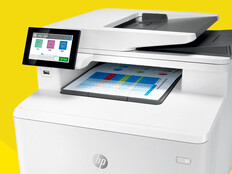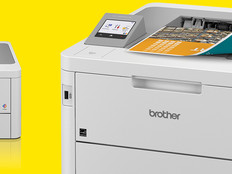3 Ways Managed Print Services Can Improve State and Local Agency Operations
As with any other technology tool, printers, copiers and multifunction devices should make life, and work, easier for government agencies who already have a lot on their plates. But within too many agencies, printing is a source of stress and confusion. Ink and toner levels run low, wasted paper and electricity costs stack up, and each department often buys its own equipment — frustrating users and tying up the time of IT staffers as they attempt to troubleshoot dozens of different devices.
At many government agencies, print exists in a sort of limbo between IT and operational departments. And because no single department “owns” the technology, it frequently sprawls throughout departments, creating management headaches and inefficiencies.
That’s why many government agencies are turning to managed print services (MPS) providers. The term “MPS” encompasses a broad range of services offered by partners and vendors, from simplifying ink and toner ordering to the rigorous redesign and ongoing management of an organization’s entire print environment. In an effective MPS engagement, organizations can save both time and money, while also shoring up security vulnerabilities.
“It’s something that can be offloaded from the IT manager’s plate,” says Kimberly Moffett, a program manager for managed print services at CDW. “It helps them control their costs, and it helps them streamline and automate their business processes. An MPS provider can tell you what’s overutilized and what’s underutilized. It makes things more efficient, and it frees up time for IT teams to work on more strategic projects.”
1. MPS Simplifies Agencies' Printer Woes
Brian Healy, senior manager of managed print services for Brother, says that every MPS engagement should begin with a discussion about the agency’s goals for the program, followed by a robust assessment of the existing environment. Almost invariably, Healy says, MPS providers find that they’re able to consolidate printing to fewer machines and reduce the overall use of ink, toner and paper. “If it’s a previously unmanaged environment, you’re almost guaranteed to reduce costs,” he says.
Many government agencies can see substantial cost benefits even from simple engagements, such as CDW’s Printer Supplies Program, a no-cost, no-contract program that gives users discounts and free shipping on print consumables across all manufacturers. The program also gives agencies the option to install software that will trigger alerts when supplies run low, and can even automate ordering.
“It’s offering the customer a solution that fits their needs,” says Alison Hill, supervisor for managed print services at CDW. “If a company just wants free shipping, that’s fine. But if they want to be more hands-off and not have to worry about ordering, we can bump them up to those levels, too.”
Enrollment in the program, Hill says, has increased tenfold over the past three years and can be a huge time and resource saver for paper-heavy agencies.
2. Print Services Help States Get Sustainable
While many agencies first look to MPS providers as a way of reducing the total cost of ownership of their print environments, the potential business benefits go far deeper.
“It’s not all about restricting printing,” says Valerie Alde-Hayman, an analyst with Gap Intelligence. “The true savings aren’t just about pages. They’re about automated workflows and saving time.”
For example, Alde-Hayman says, an MPS partner can help agencies and departments automate processes, such as billing, that previously required employees to spend large amounts of time manually scanning and copying.
“If you can put workflows in place that reduce those man-hours and prevent errors, you’re saving money and you’re saving time,” she says. “It’s those simple manual processes that organizations don’t think about – or maybe they don’t even know there’s an automated workflow.”
A more streamlined print environment, with fewer total devices and device types, can also improve productivity. MPS providers minimize costly downtime for printers and copiers. Further, employees are likely to become more familiar with print tools (and encounter fewer problems that require troubleshooting help) when they work with a smaller number of products. When the start of a meeting is delayed because a printer is low on toner or an employee is struggling with an unreliable copier, an agency can lose productive minutes from dozens of employees.
Additionally, Healy says, reductions in paper and toner usage can help local governments to meet their goals for sustainability, which is a growing area of concern for many states, counties and cities.
“It’s reducing print, reducing electricity consumption, even increasing the yield of toner — all of that goes to sustainability,” he says. “If you’re going from 200 print devices to 100 devices, you’re going to be reducing energy consumption.”
3. Prioritize Printer Endpoint Security
Historically, printers, copiers and scanners have been largely ignored in many agencies’ cybersecurity strategies. That’s beginning to change, however, as security professionals become more aware of the potential damage that might result from an attack on a device — or even from sensitive information thoughtlessly left in a printer tray.
By monitoring device health, pushing out updates and patches, and implementing security and control measures, an MPS partner can help governments improve their overall security posture.
“In a typical unmanaged environment, users can gain access not only to the devices themselves, but to features within those devices that should be reserved for departments like human resources or finance,” Healy says.
Print security is an “evolving theme” that many print vendors and MPS partners are now becoming increasingly aware of, Alde-Hayman says. “There’s a very wide range of vulnerabilities, from ‘I left confidential information on an output tray, and now everyone knows what my boss earns’, to a full-on data hack that originates in a printer,” she says.
“By having MPS in place, organizations can often prevent or identify potential breaches,” Alde-Hayman adds. “A partner can offer print security, or at least bring an awareness of it to the organization.”








